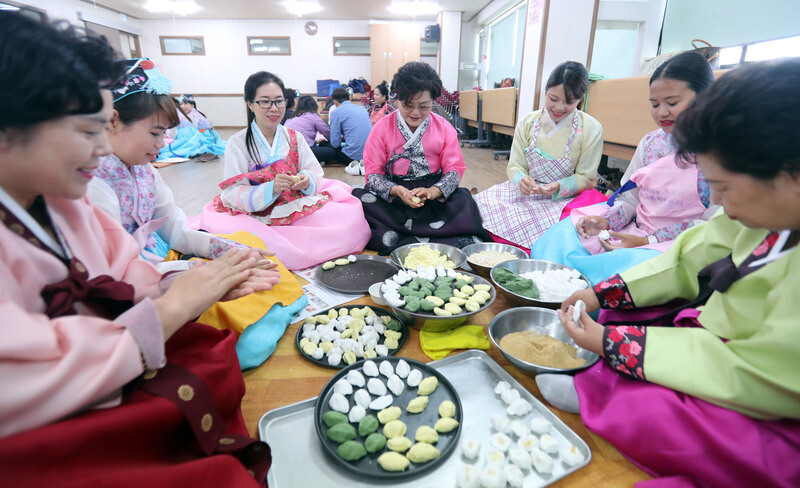hankyoreh
Links to other country sites 다른 나라 사이트 링크
Vietnamese women now account for highest number of foreign brides in South Korea

Vietnamese women outnumbered Chinese women for the first time this year as spouses in multicultural marriages with South Korean men. The average childbirth age for women in multicultural families also increased to over 30, with more births for mothers in their early thirties than in their late twenties.
Statistics Korea published a report on Nov. 16 on trends for South Korea’s multicultural population in 2016. The results showed 21,709 multicultural marriages last year, down by 753 (3.4%) from 22,462) in 2015. The decline in multicultural marriages was milder than the 7.0% drop from 2015 levels in the number of all marriages. A multicultural marriage is considered to be one in which a South Korean national has a spouse who is a foreign national or naturalized South Korean.
In terms of spouse nationalities, Vietnamese women accounted for the largest percentage of wives at 27.9%, followed by women from China (26.9%) and the Philippines (4.3%). While the percentage of female spouses from China has steadily declined from 38.6% when statistics on multicultural families were first recorded, they remained ranked first through 2015 (27.9%). Last year, however, they were overtaken by female spouses from Vietnam, declining by one percentage point while the latter rose by 4.8 percentage points.
“There has been an increase in the number of Vietnamese people coming to South Korea for employment or study amid the Korean Wave, while multicultural marriages have declined for Korean-Chinese people, who account for the majority of Chinese people in South Korea, as other avenues for them to reside here permanently have arisen besides marriage,” explained Lee Ji-yeon, head of Statistics Korea’s population trend division.
Chinese men remained in first place among male spouses in multicultural families at 9.9%, followed by men from the US (6.4%) and Vietnam (2.6%). For the first time since statistics were kept, more women in multicultural families had children in their early thirties (31.3%) than in their late twenties (31.1%). Just 18.5% had children in their early twenties. The average age at childbirth was 30, or 2.3 years later than in 2008. The average childbirth age for South Korean mothers in general is higher at 32.6 years. The numbers showed a similar trend to South Korean families in general, with couples waiting an average of 3.4 years after marriage to have their first child.
“Members of multicultural families have assimilated greatly to South Korea, and their marriage and childbirth patterns have become very similar to those of South Koreans,” Lee Ji-yeon explained.
While multicultural families tend to have large numbers of children, the figures suggest claims that multicultural marriage should be continue to be encouraged as a means of responding to South Korea’s low birth rate appear likely to lose credence in the future.
By Jung Eun-joo, staff reporter
Please direct questions or comments to [english@hani.co.kr]

Editorial・opinion
![[Column] Has Korea, too, crossed the Rubicon on China? [Column] Has Korea, too, crossed the Rubicon on China?](https://flexible.img.hani.co.kr/flexible/normal/500/300/imgdb/original/2024/0419/9317135153409185.jpg) [Column] Has Korea, too, crossed the Rubicon on China?
[Column] Has Korea, too, crossed the Rubicon on China?![[Correspondent’s column] In Japan’s alliance with US, echoes of its past alliances with UK [Correspondent’s column] In Japan’s alliance with US, echoes of its past alliances with UK](https://flexible.img.hani.co.kr/flexible/normal/500/300/imgdb/original/2024/0419/2317135166563519.jpg) [Correspondent’s column] In Japan’s alliance with US, echoes of its past alliances with UK
[Correspondent’s column] In Japan’s alliance with US, echoes of its past alliances with UK- [Editorial] Does Yoon think the Korean public is wrong?
- [Editorial] As it bolsters its alliance with US, Japan must be accountable for past
- [Guest essay] Amending the Constitution is Yoon’s key to leaving office in public’s good graces
- [Editorial] 10 years on, lessons of Sewol tragedy must never be forgotten
- [Column] A death blow to Korea’s prosecutor politics
- [Correspondent’s column] The US and the end of Japanese pacifism
- [Guest essay] How Korea turned its trainee doctors into monsters
- [Guest essay] As someone who helped forge Seoul-Moscow ties, their status today troubles me
Most viewed articles
- 1[Column] The clock is ticking for Korea’s first lady
- 2After 2 months of delayed, denied medical care, Koreans worry worst may be yet to come
- 3[Column] Has Korea, too, crossed the Rubicon on China?
- 4US overtakes China as Korea’s top export market, prompting trade sanction jitters
- 5[Correspondent’s column] In Japan’s alliance with US, echoes of its past alliances with UK
- 6Hong Se-hwa, voice for tolerance whose memoir of exile touched a chord, dies at 76
- 7All eyes on Xiaomi after it pulls off EV that Apple couldn’t
- 8[News analysis] After elections, prosecutorial reform will likely make legislative agenda
- 9More South Koreans, particularly the young, are leaving their religions
- 10John Linton, descendant of US missionaries and naturalized Korean citizen, to lead PPP’s reform effo